Adaptive Equivalent Consumption Minimization Strategy for Hybrid Heavy-Duty Truck Based on Driving Condition Recognition and Parameter Optimization
Abstract
1. Introduction
1.1. Literature Review
1.2. Motivation
1.3. Contributions
1.4. Outline
2. Powertrain Structure and System Model
2.1. Vehicle Model Based on AMESim
2.1.1. Engine Model
2.1.2. Motor Model
2.1.3. Battery Model
2.1.4. Vehicle Longitudinal Dynamic Model
3. DCR of Hybrid Heavy-Duty Vehicle Based on Neural Network
3.1. Construction of Typical Sample Database of Driving Cycles
3.2. Algorithm Design of DCR Base on Neural Network
4. Key Parameter Optimization of ECMS Based on PSO
4.1. Principles of ECMS
4.2. Parameter Optimization of ECMS Based on PSO
4.3. The Simulation and Discussion of PSO-ECMS
5. A-ECMS Based on DCR and Key Parameter Optimization
5.1. The Principle of A Novel A-ECMS
5.2. Comparison Analysis
5.3. Discussion
6. Conclusions
Author Contributions
Funding
Conflicts of Interest
References
- Zhao, Y.; Onat, N.C.; Kucukvar, M.; Tatari, O. Carbon and energy footprints of electric delivery trucks: A hybrid multi-regional input-output life cycle assessment. Trans. Res. D-Transp. Environ. 2016, 47, 195–207. [Google Scholar] [CrossRef]
- Quiros, D.C.; Smith, J.; Thiruvengadam, A.; Huai, T.; Hu, S. Greenhouse gas emissions from heavy-duty natural gas, hybrid, and conventional diesel on-road trucks during freight transport. Atmos. Environ. 2017, 168, 36–45. [Google Scholar] [CrossRef]
- Feng, Y.; Dong, Z. Optimal energy management with balanced fuel economy and battery life for large hybrid electric mining truck. J. Power Sources 2020, 454, 227948. [Google Scholar] [CrossRef]
- Xu, C.; Guo, K.; Yang, F. A Comparative study of different hybrid electric powertrain architectures for heavy-duty truck. IFAC-Pap. OnLine 2018, 51, 746–753. [Google Scholar] [CrossRef]
- Sorrentino, M.; Rizzoni, G.; Arsie, I. Analysis of a rule-based control strategy for on-board energy management of series hybrid vehicles. Control Eng. Pract. 2011, 19, 1433–1441. [Google Scholar] [CrossRef]
- Liu, Y.; Gao, J.; Qin, D.; Zhang, Y.; Lei, Z. Rule-corrected energy management strategy for hybrid electric vehicles based on operation-mode prediction. J. Clean. Prod. 2018, 188, 796–806. [Google Scholar] [CrossRef]
- Engbroks, L.; Görke, D.; Schmiedler, S.; Strenkert, J.; Geringer, B. Applying forward dynamic programming to combined energy and thermal management optimization of hybrid electric vehicles. IFAC-Pap. OnLine 2018, 51, 383–389. [Google Scholar] [CrossRef]
- Zhou, W.; Yang, L.; Cai, Y.; Ying, T. Dynamic programming for new energy vehicles based on their work modes part I: Electric vehicles and hybrid electric vehicles. J. Power Sources 2018, 406, 151–166. [Google Scholar] [CrossRef]
- Schmid, R.; Bürger, J.; Bajcinca, N. A comparison of PMP-based energy management strategies for Plug-in-hybrid electric vehicles. IFAC-Pap. OnLine 2019, 52, 592–597. [Google Scholar] [CrossRef]
- Ou, K.; Yuan, W.; Choi, M.; Yang, S.; Jung, S.; Kim, Y. Optimized power management based on adaptive-PMP algorithm for a stationary PEM fuel cell/battery hybrid system. Int. J. Hydrogen Energ. 2018, 43, 15433–15444. [Google Scholar] [CrossRef]
- Peng, J.; He, H.; Xiong, R. Rule based energy management strategy for a series–parallel plug-in hybrid electric bus optimized by dynamic programming. Appl. Energy 2017, 185, 1633–1643. [Google Scholar] [CrossRef]
- Chen, S.; Hung, Y.; Wu, C.; Huang, S. Optimal energy management of a hybrid electric powertrain system using improved particle swarm optimization. Appl. Energy 2015, 160, 132–145. [Google Scholar] [CrossRef]
- Chen, Z.; Mi, C.C.; Xiong, R.; Xu, J.; You, C. Energy management of a power-split plug-in hybrid electric vehicle based on genetic algorithm and quadratic programming. J. Power Sources 2014, 248, 416–426. [Google Scholar] [CrossRef]
- Ju, F.; Zhuang, W.; Wang, L.; Zhang, Z. Optimal sizing and adaptive energy management of a novel four-wheel-drive hybrid powertrain. Energy 2019, 187, 116008. [Google Scholar] [CrossRef]
- Payri, F.; Guardiola, C.; Pla, B.; Blanco-Rodriguez, D. On a stochastic approach of the ECMS method for energy management in hybrid electric vehicles. IFAC Proc. Vol. 2012, 45, 341–348. [Google Scholar] [CrossRef]
- Simmons, K.; Guezennec, Y.; Onori, S. Modeling and energy management control design for a fuel cell hybrid passenger bus. J. Power Sources 2014, 246, 736–746. [Google Scholar] [CrossRef]
- Yang, Y.; Zhang, Y.; Tian, J.; Li, T. Adaptive real-time optimal energy management strategy for extender range electric vehicle. Energy 2020, 197, 117237. [Google Scholar] [CrossRef]
- Han, J.; Parkand, Y.; Kum, D. Optimal adaptation of equivalent factor of equivalent consumption minimization strategy for fuel cell hybrid electric vehicles under active state inequality constraints. J. Power Sources 2014, 267, 491–502. [Google Scholar] [CrossRef]
- Liu, X.; Qin, D.; Wang, S. Minimum energy management strategy of equivalent fuel consumption of hybrid electric vehicle based on improved global optimization equivalent factor. Energies 2019, 12, 2076. [Google Scholar] [CrossRef]
- Yang, C.; Du, S.; Li, L. Adaptive real-time optimal energy management strategy based on equivalent factors optimization for plug-in hybrid electric vehicle. Appl. Energy 2017, 203, 883–896. [Google Scholar] [CrossRef]
- Lei, Z.; Qin, D.; Hou, L.; Peng, J.; Liu, Y.; Chen, Z. An adaptive equivalent consumption minimization strategy for plug-in hybrid electric vehicles based on traffic information. Energy 2020, 190, 116409. [Google Scholar] [CrossRef]
- Li, S.; Hu, M.; Gong, C.; Zhan, S.; Qin, D. Energy management strategy for hybrid electric vehicle based on driving condition identification using KGA-Means. Energies 2018, 11, 1531. [Google Scholar] [CrossRef]
- Deng, T.; Luo, J.; Han, H.; Wang, M.; Cheng, D. Adaptive energy management strategy based on driving cycle identification for hybrid electric vehicles. J. Xi’an Jiaotong Univ. 2018, 52, 77–83. [Google Scholar] [CrossRef]
- Guo, S.; Zhong, S.; Zhang, A. Privacy-preserving Kruskal–Wallis test. Comput. Methods Programs Biomed. 2013, 112, 135–145. [Google Scholar] [CrossRef]
- Huang, X.; Tan, Y.; He, X. An intelligent multi-feature statistical approach for discrimination of driving conditions of hybrid electric vehicle. In Proceedings of the International Joint Conference on Neural Networks, Atlanta, GA, USA, 14–19 June 2009. [Google Scholar] [CrossRef]
- He, B. Driving Pattern Recognition and Energy Management Strategy Optimization of Hybrid Electric Heavy Truck; Wuhan Technology University: Wuhan, China, 2020. [Google Scholar]
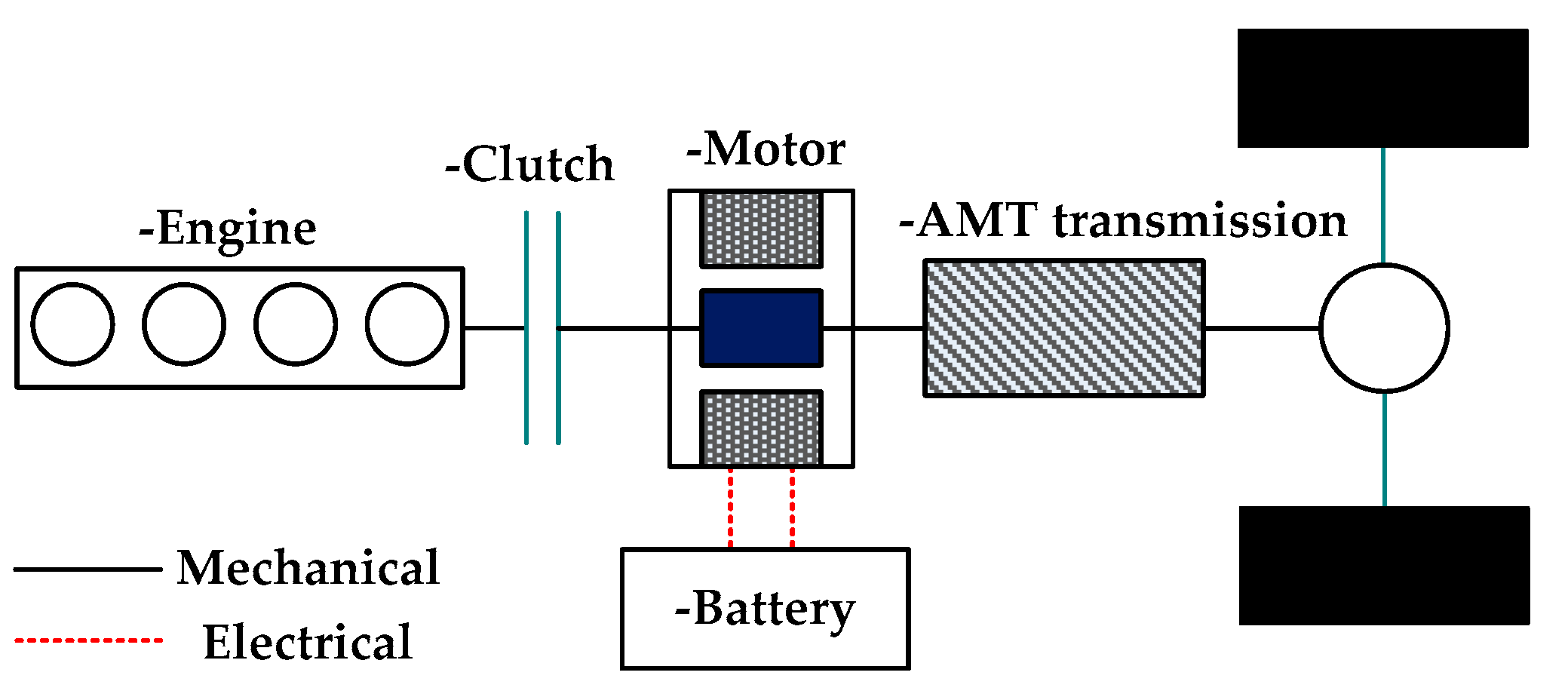
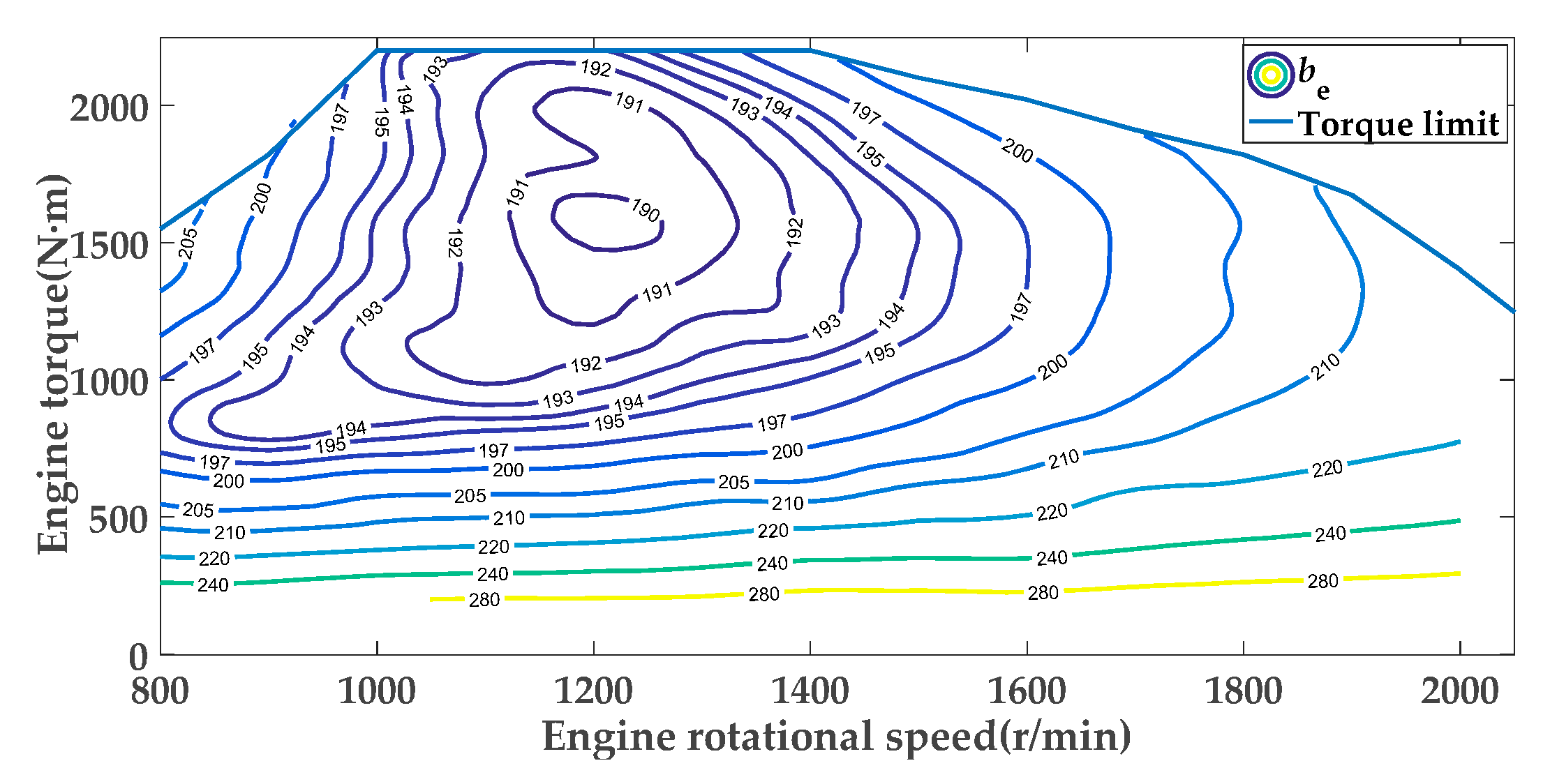
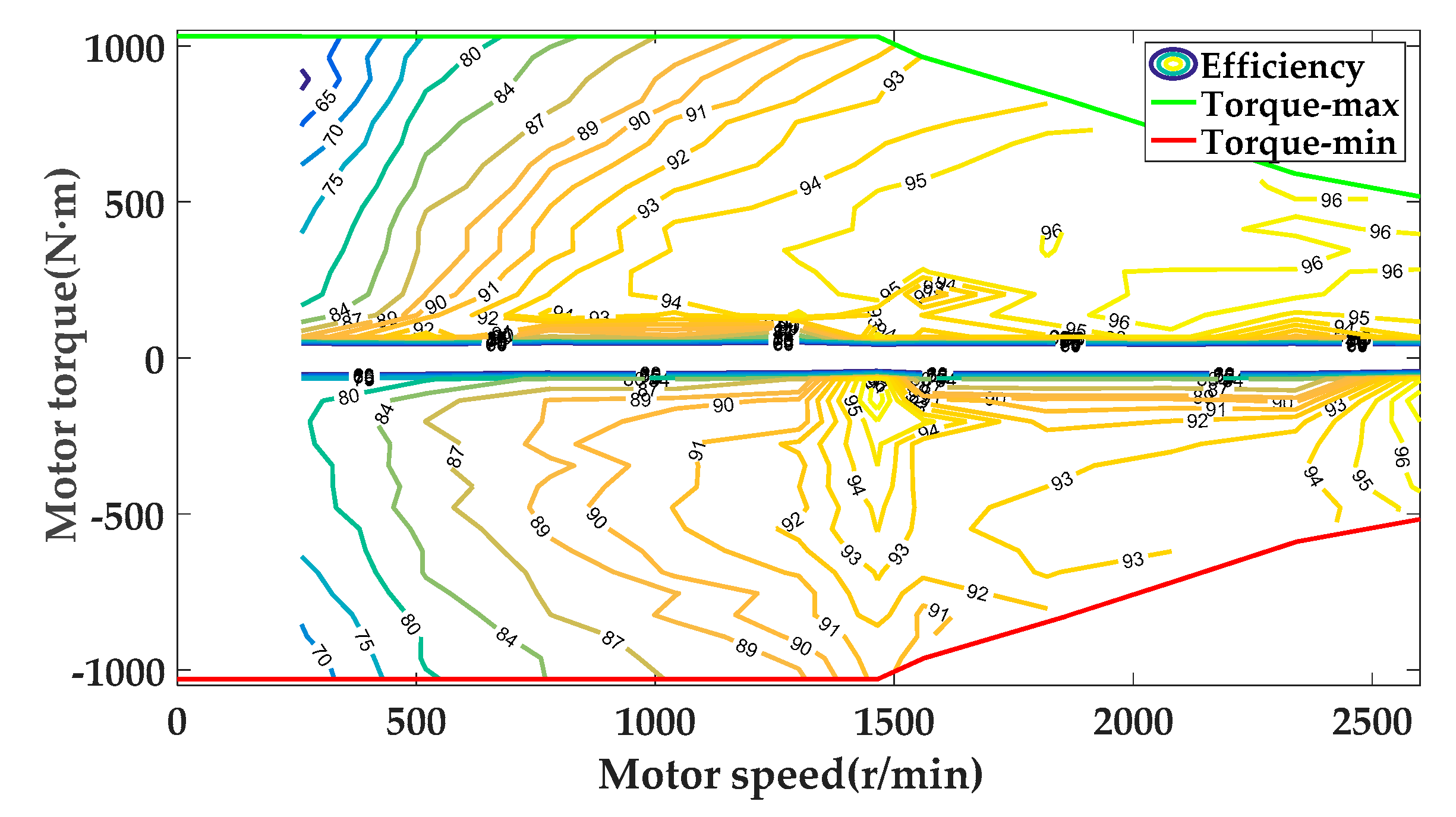
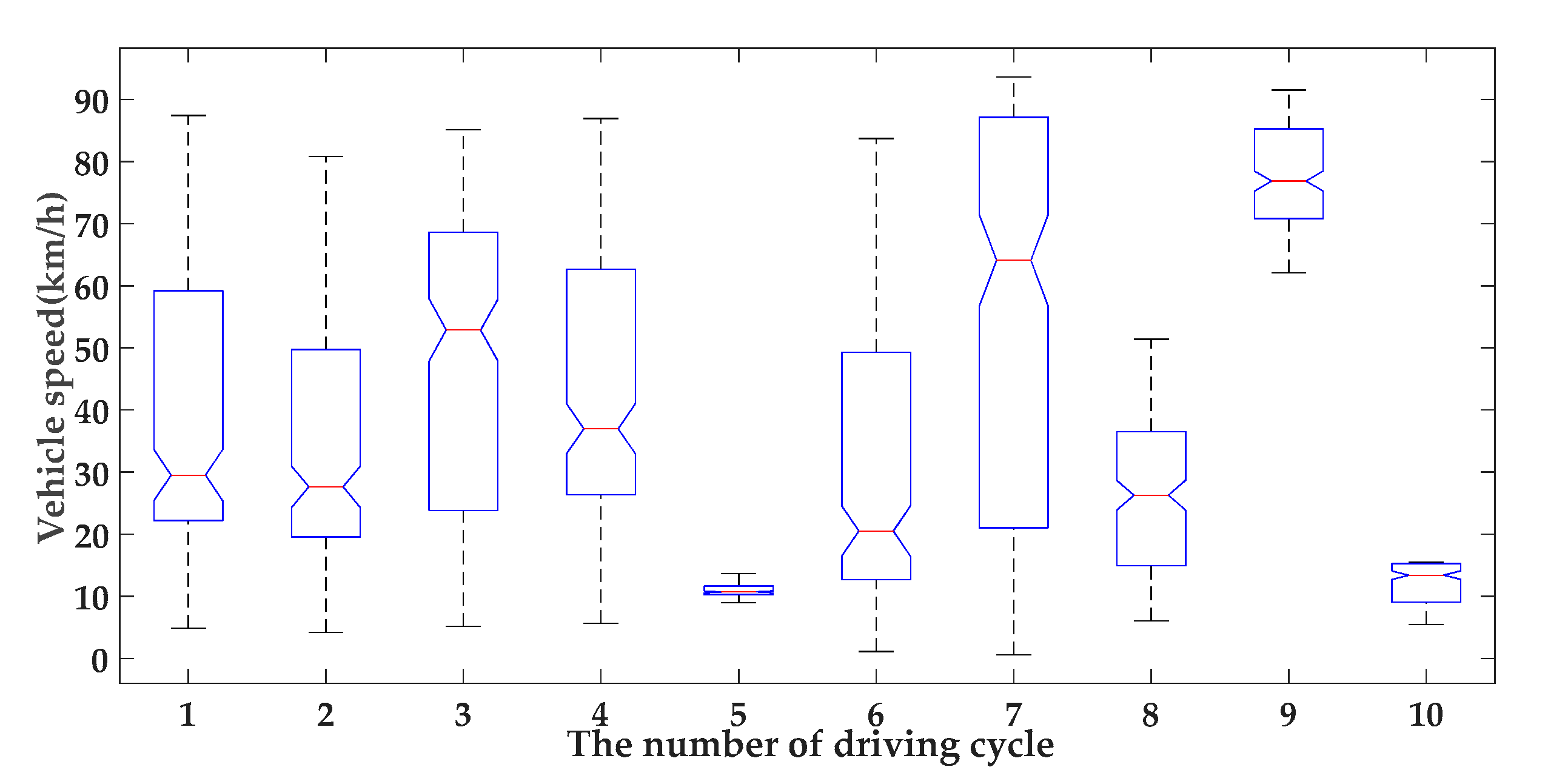
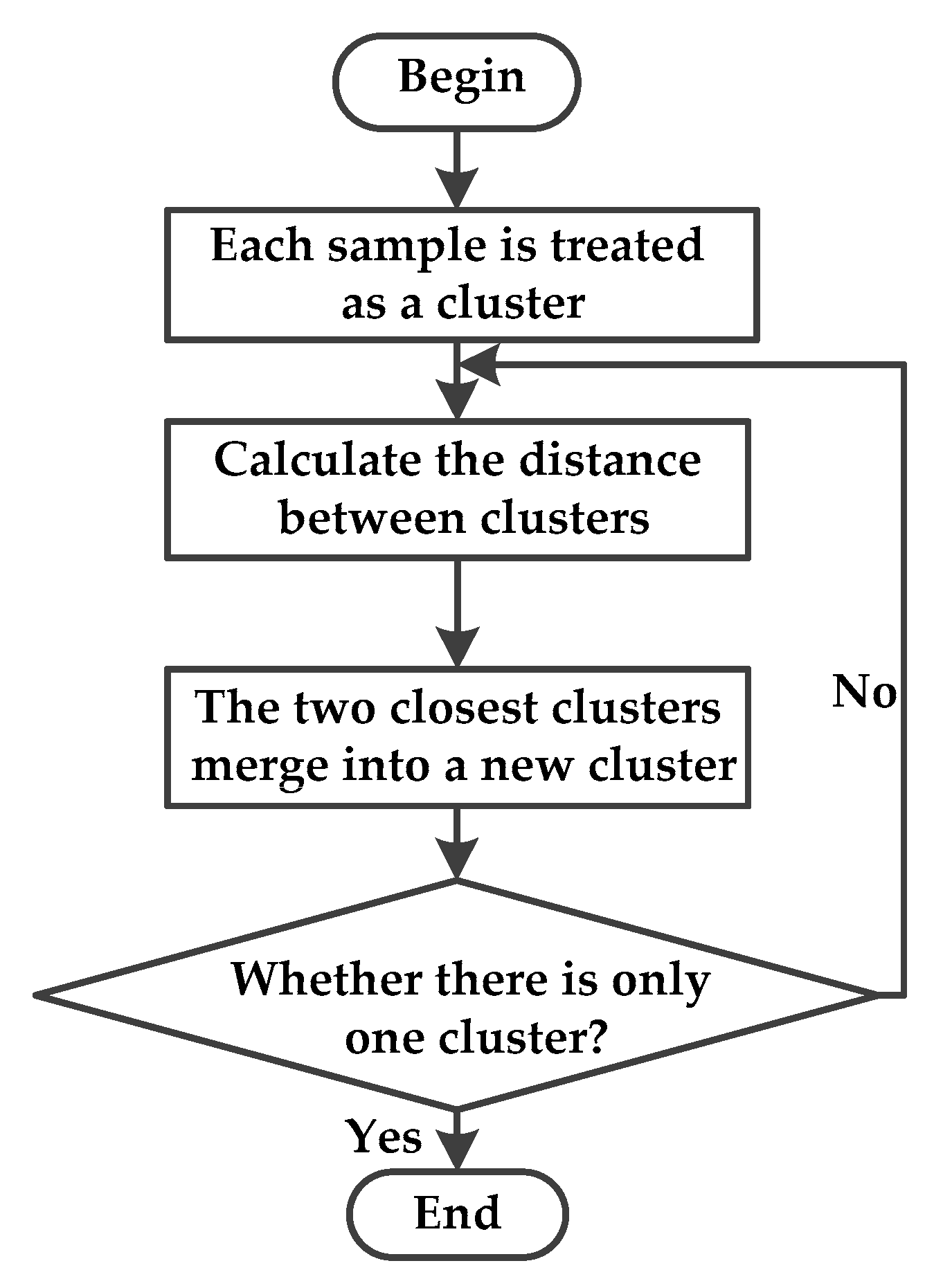
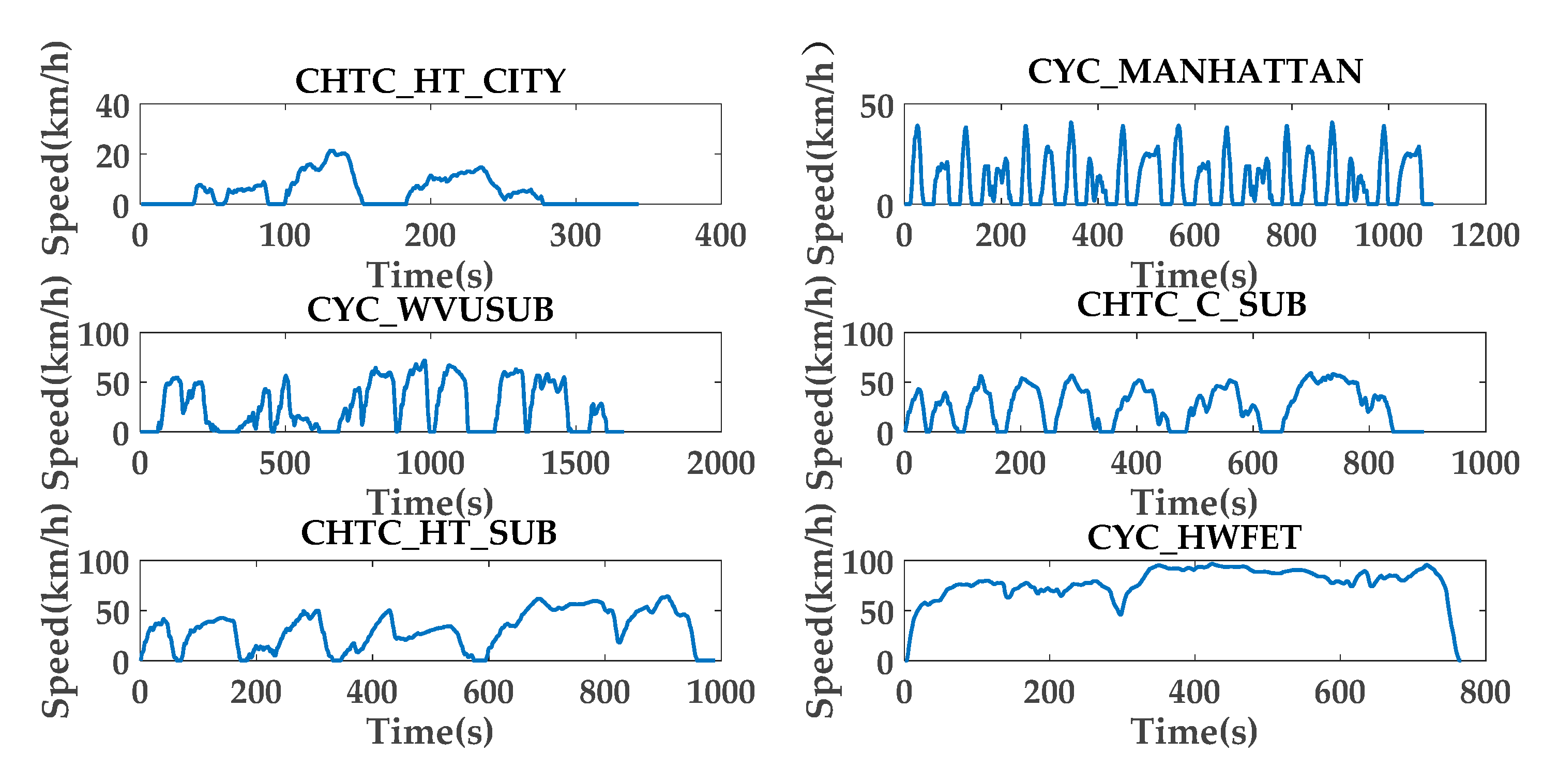
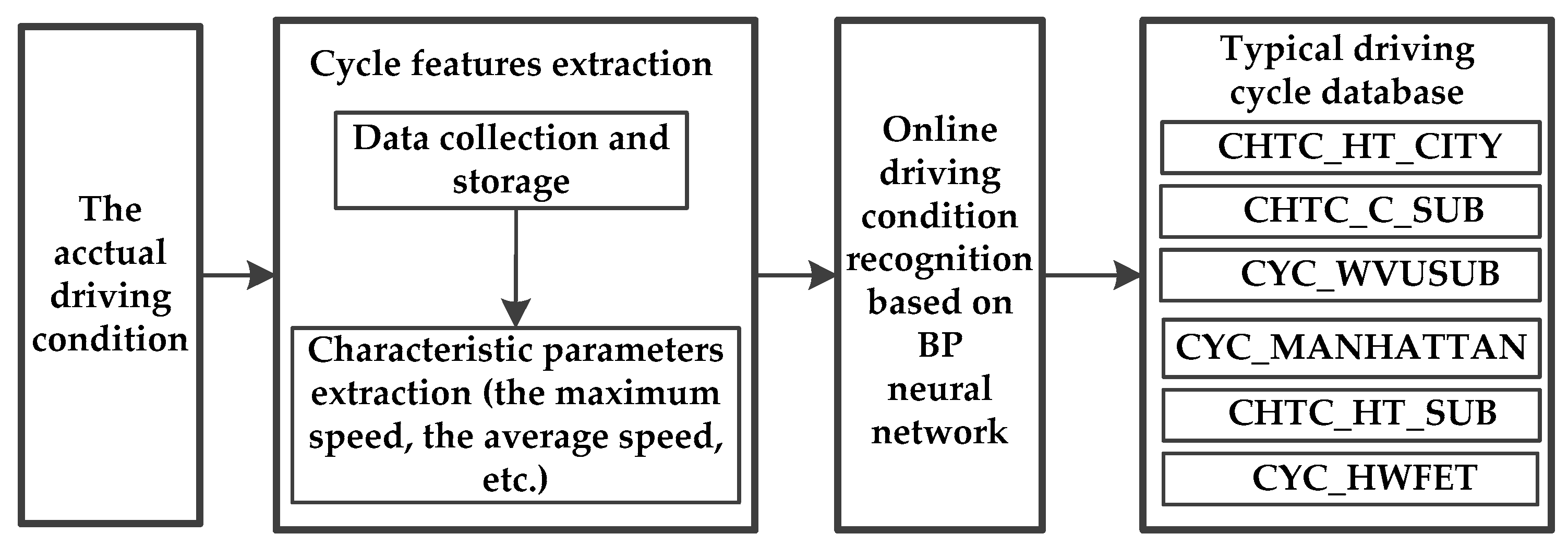
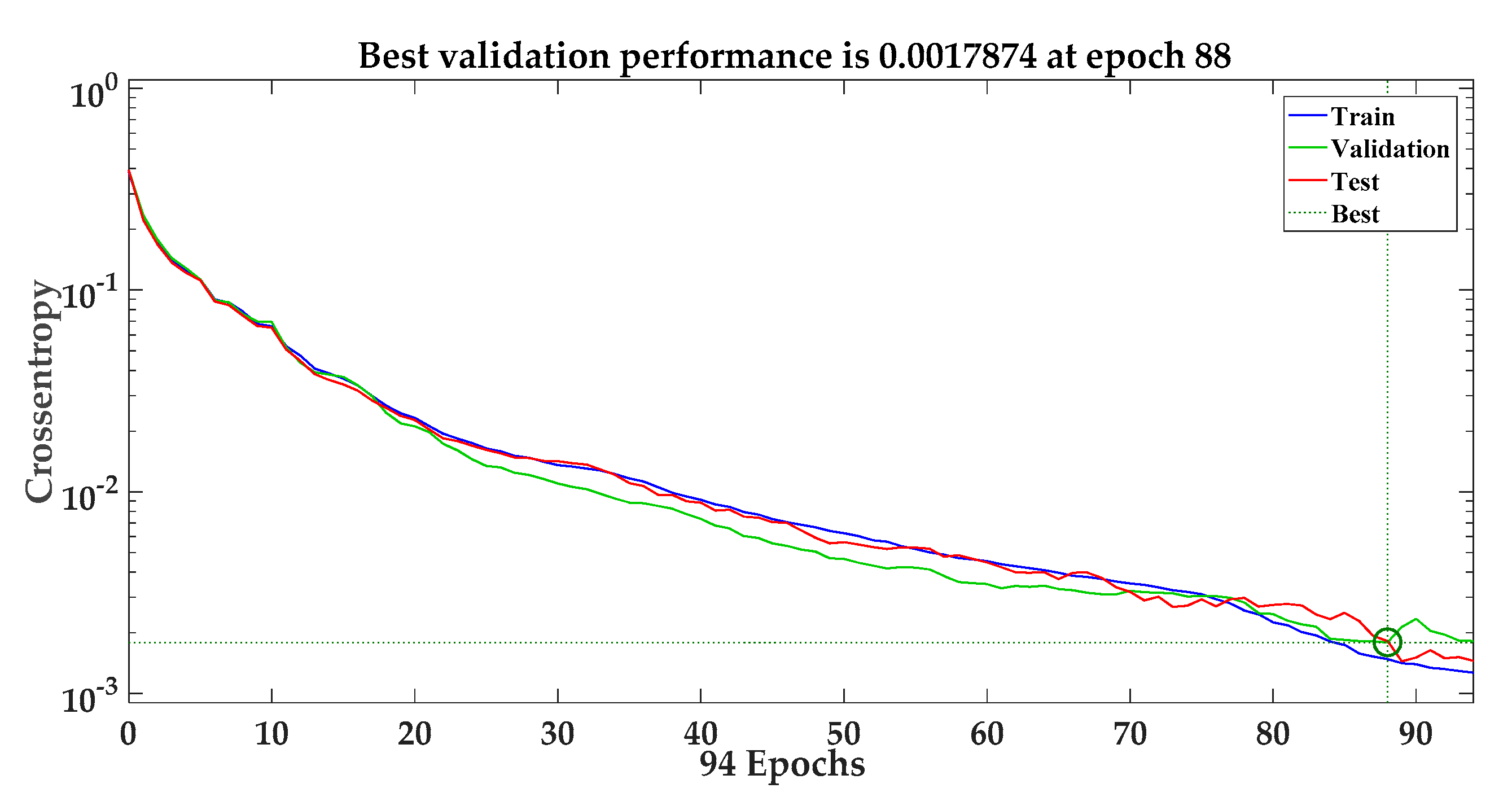
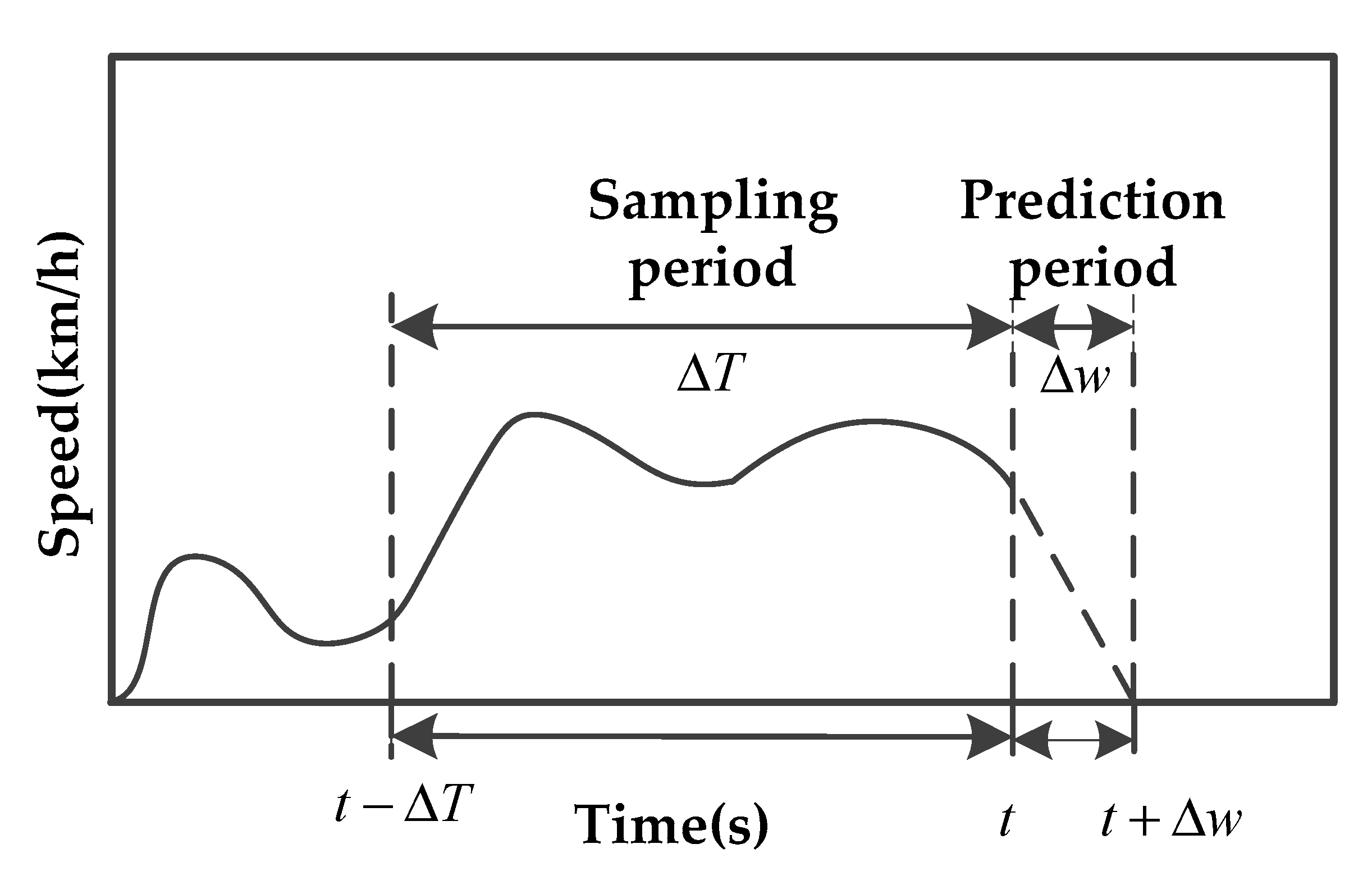
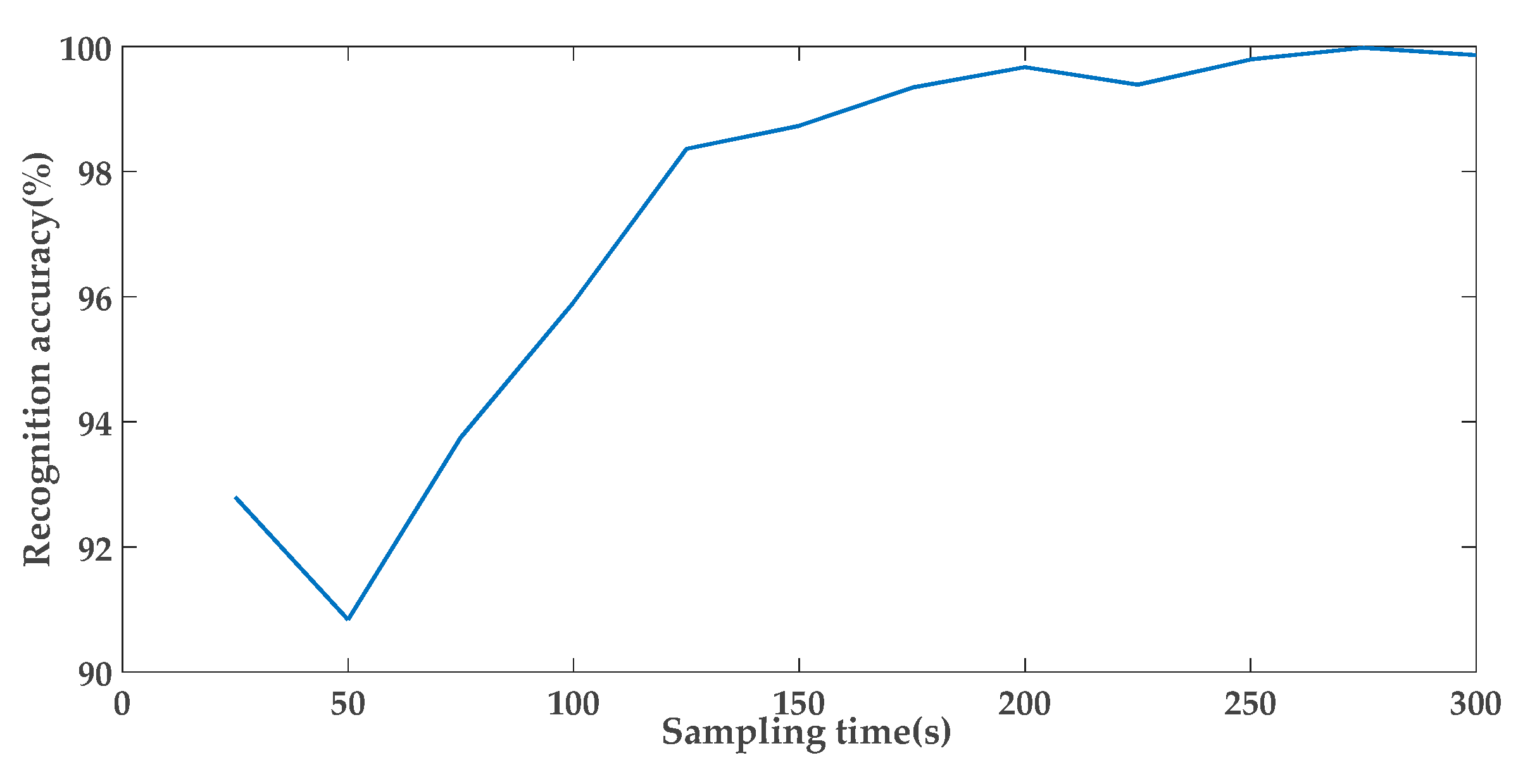
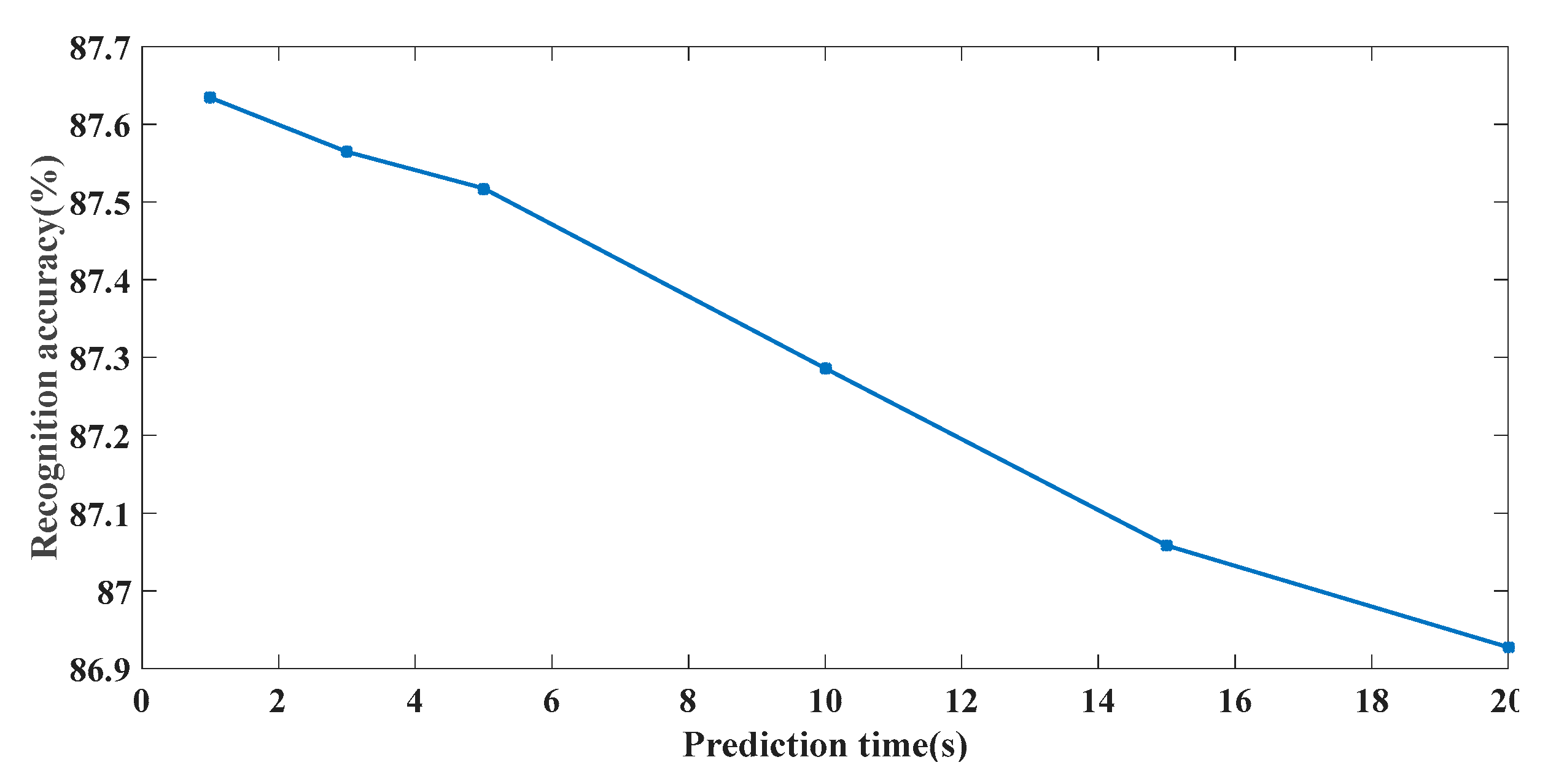
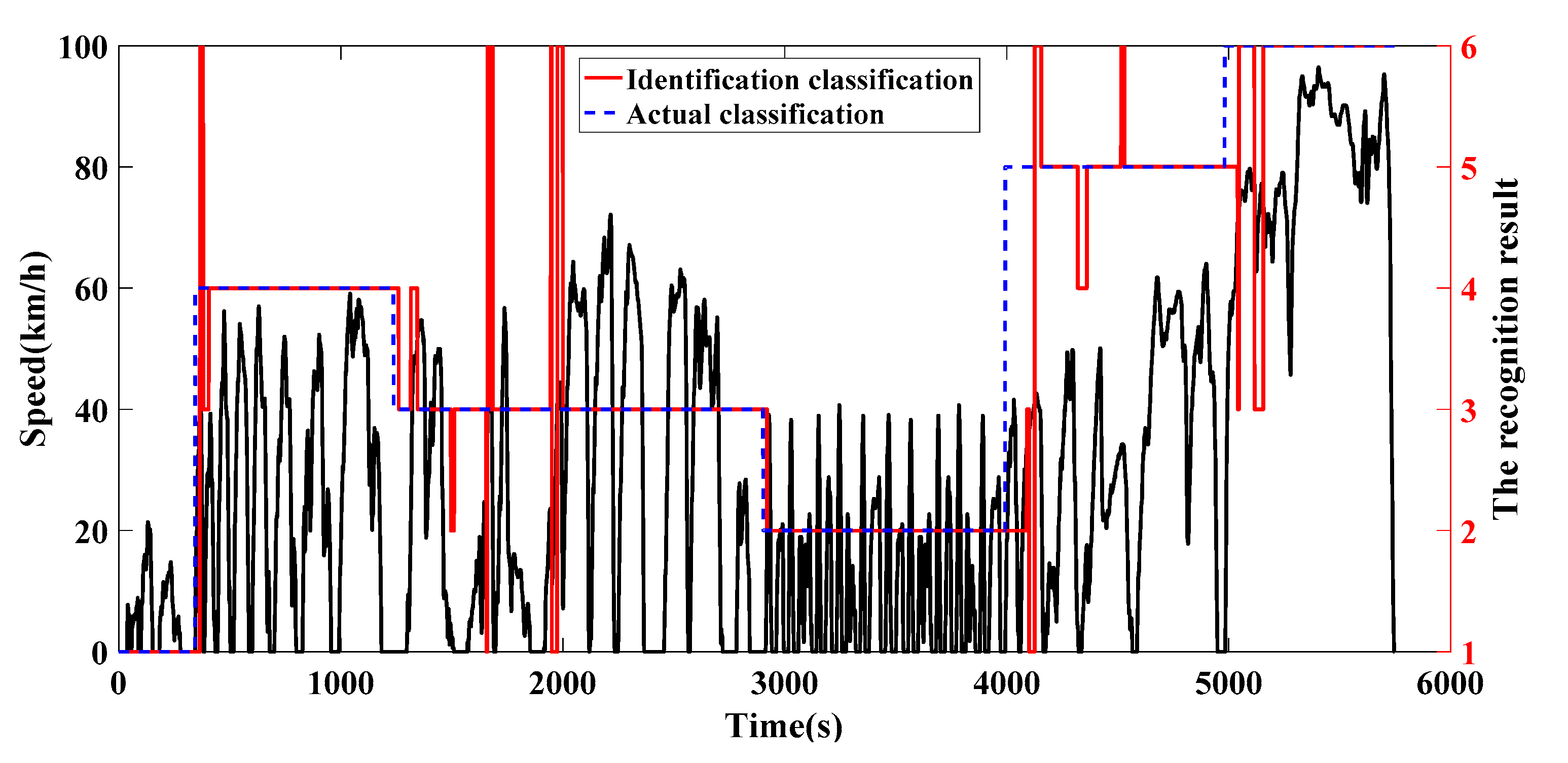
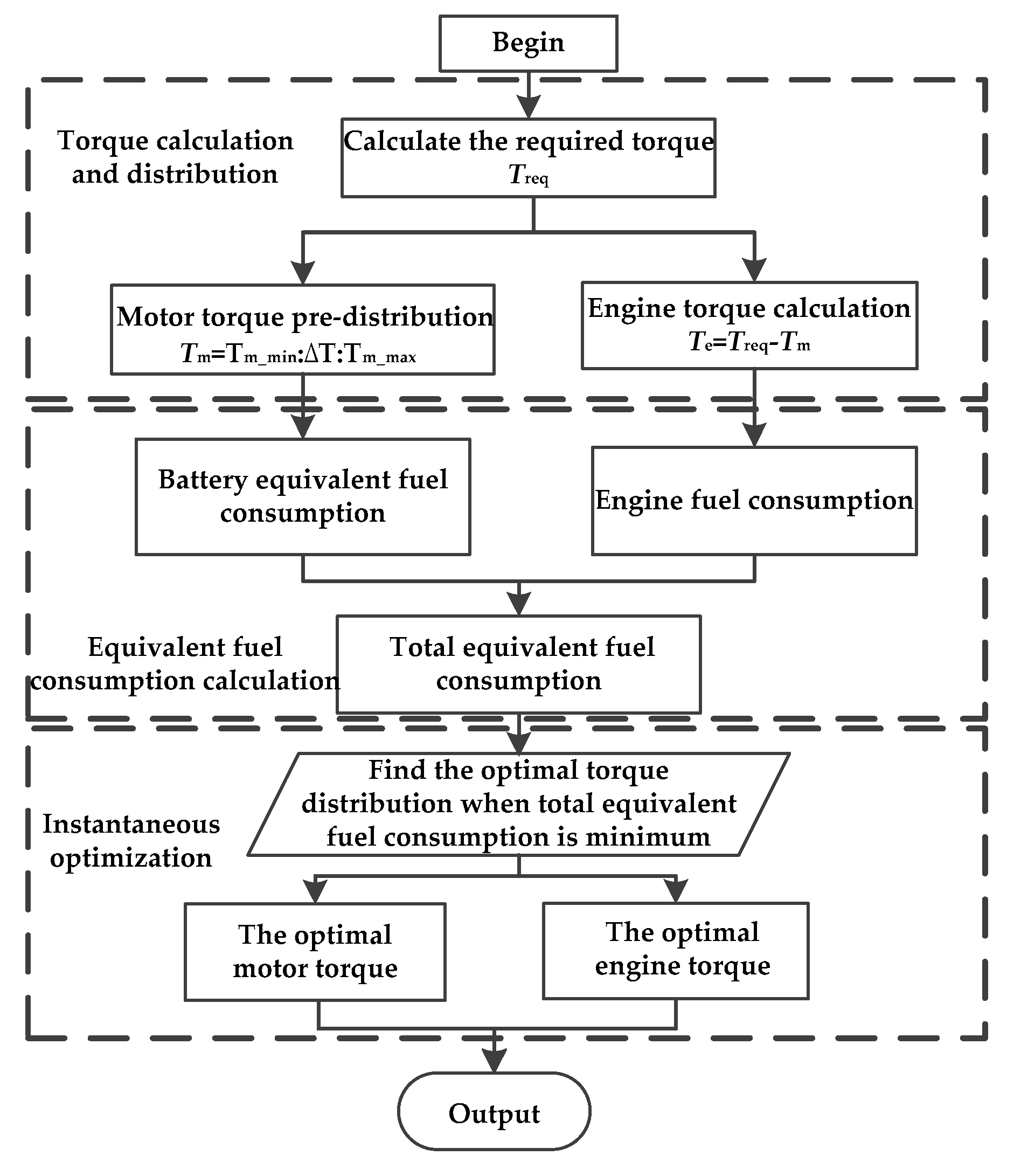
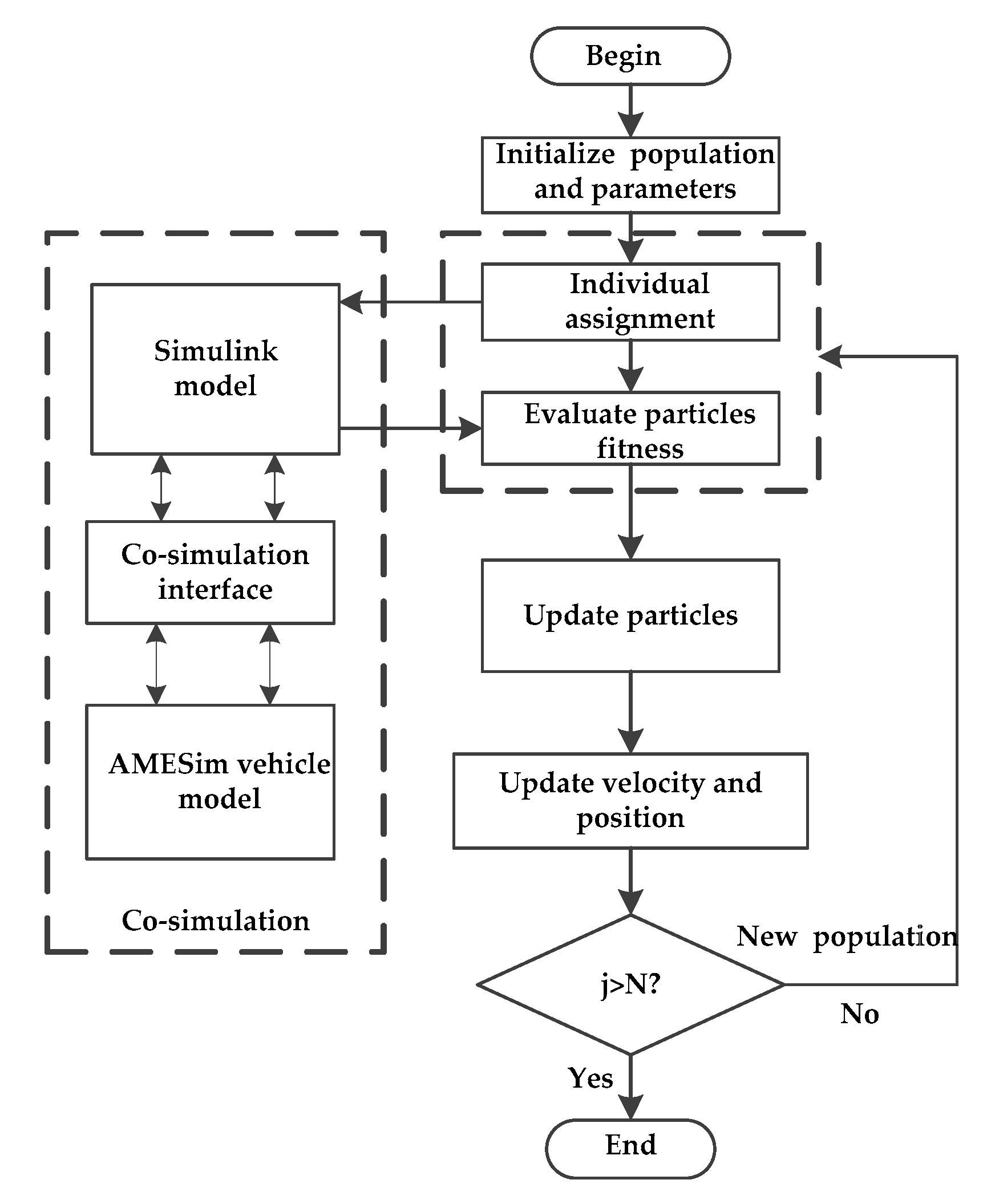
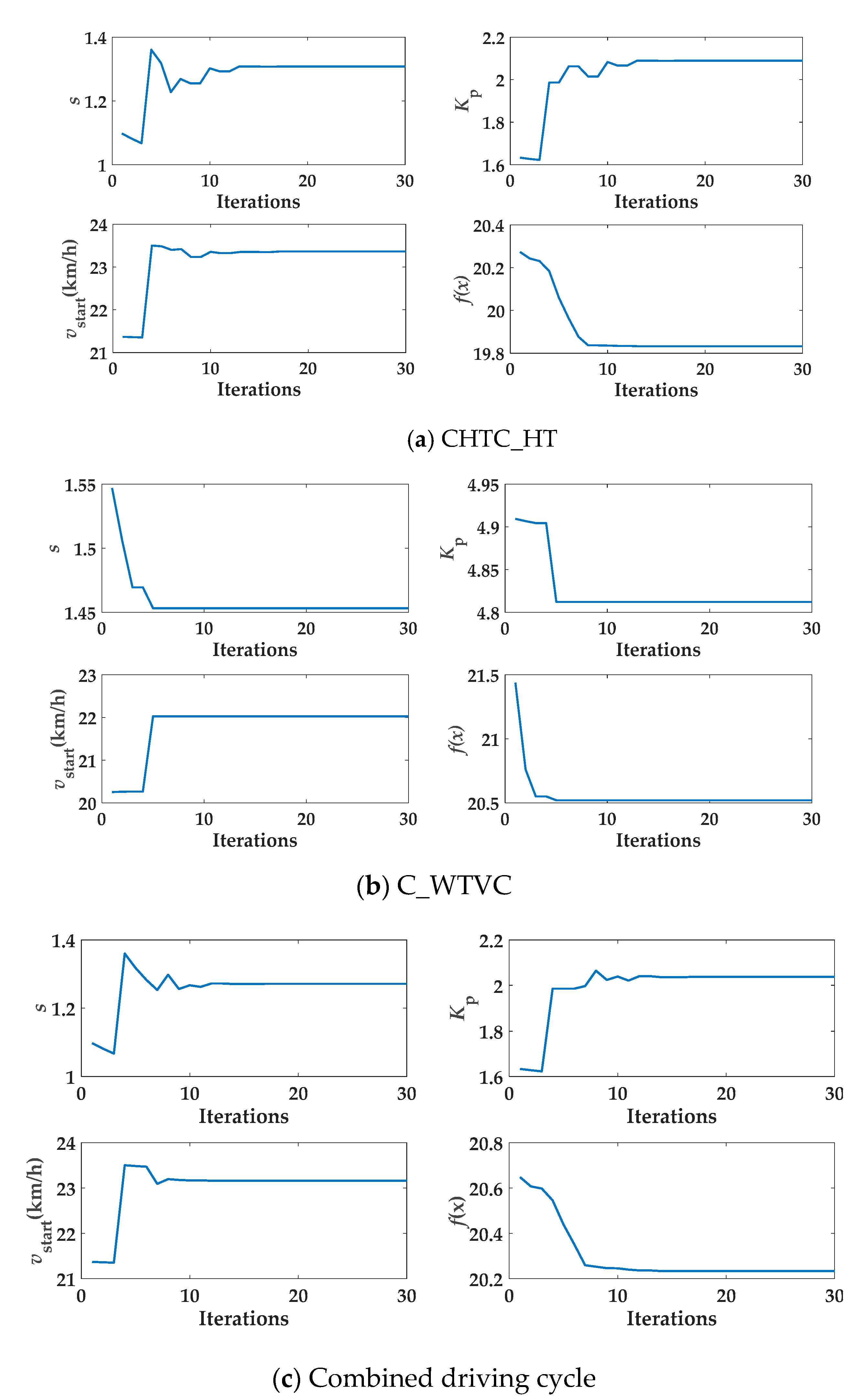
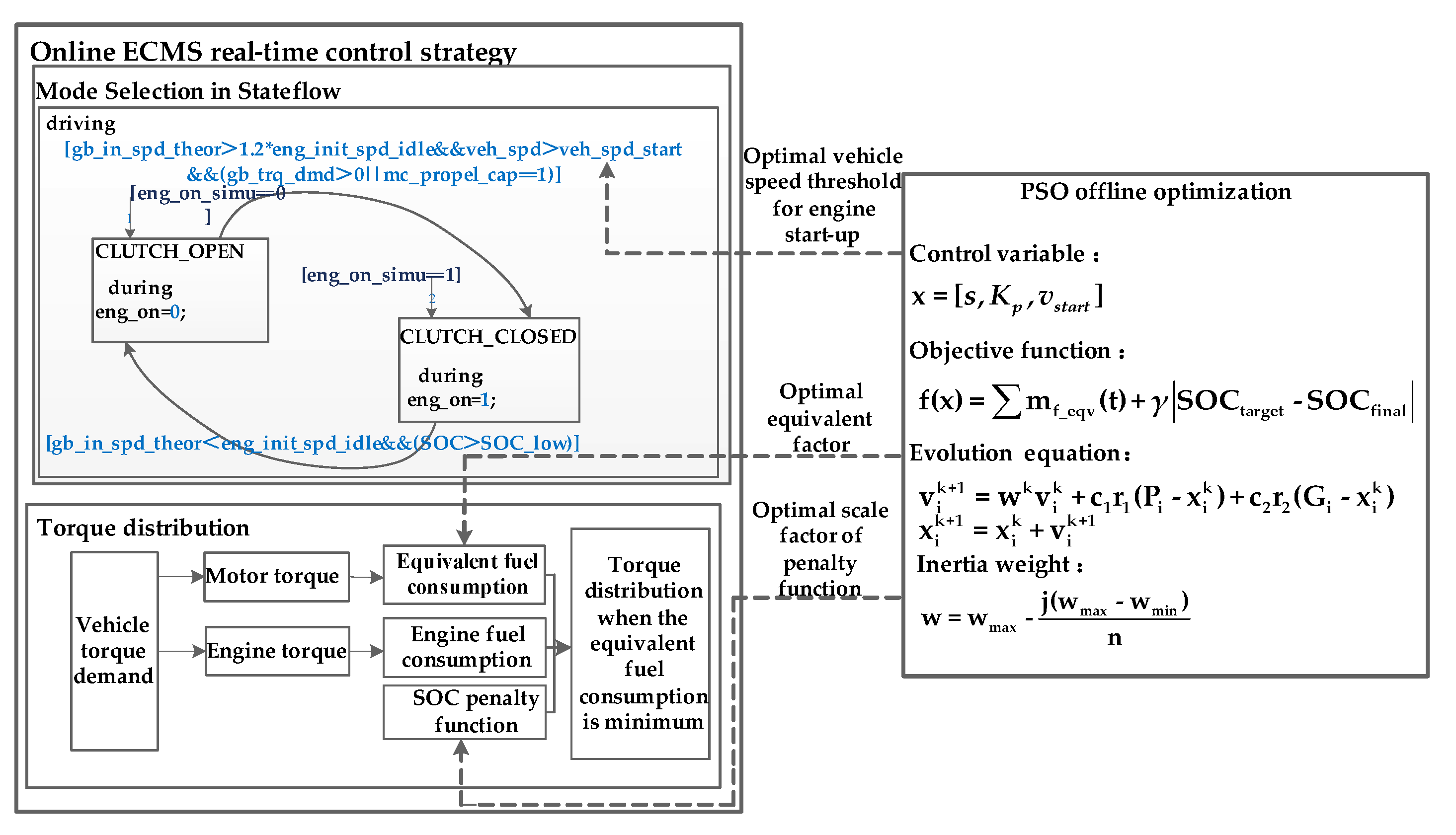
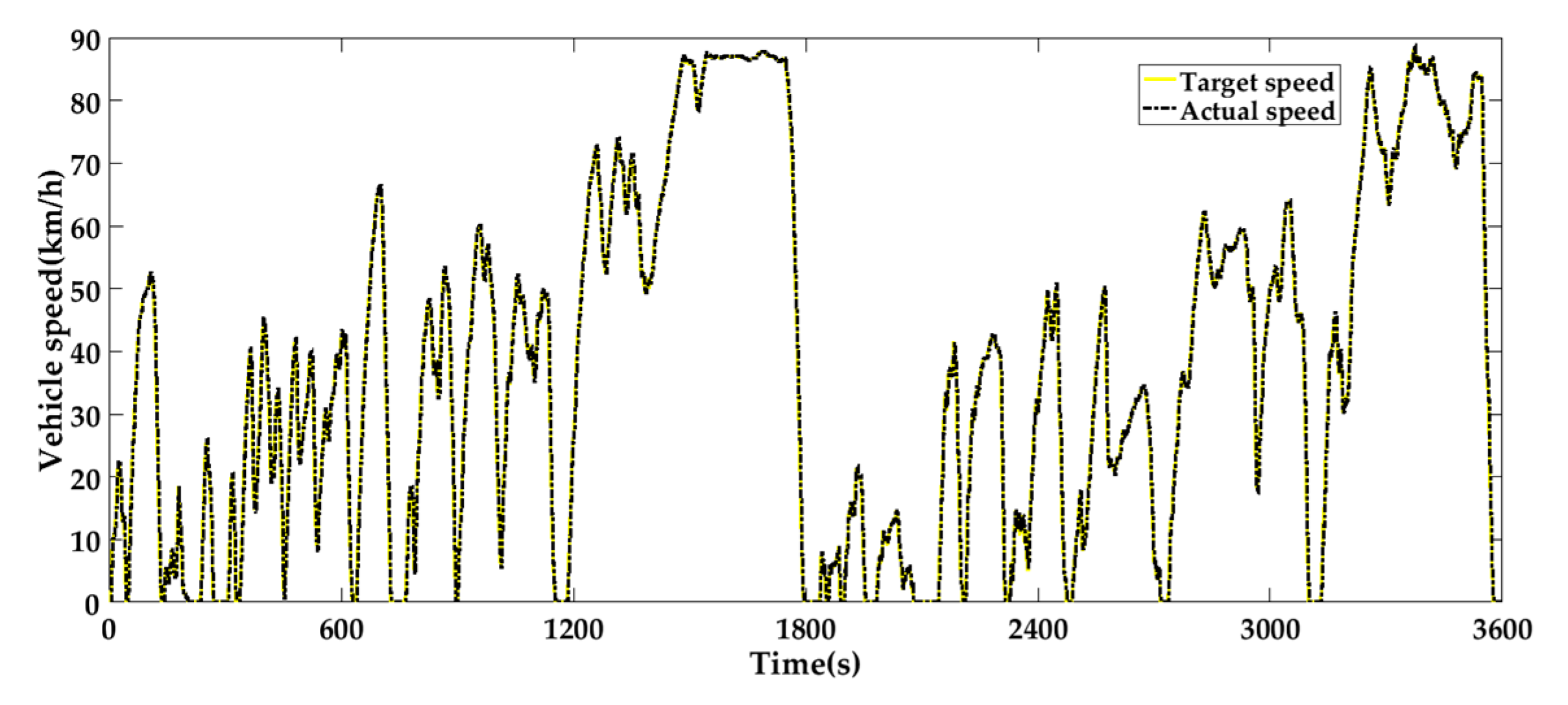
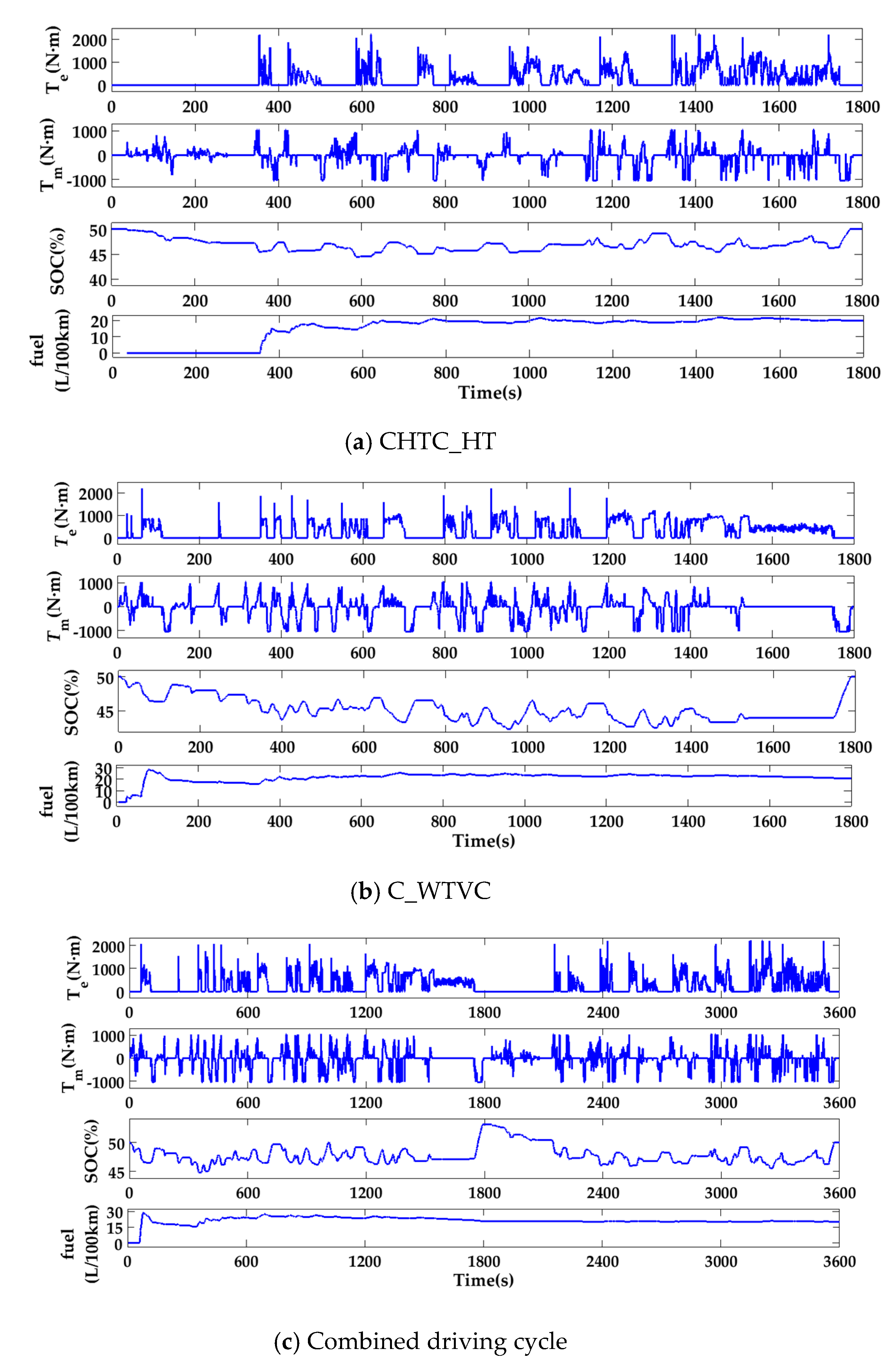
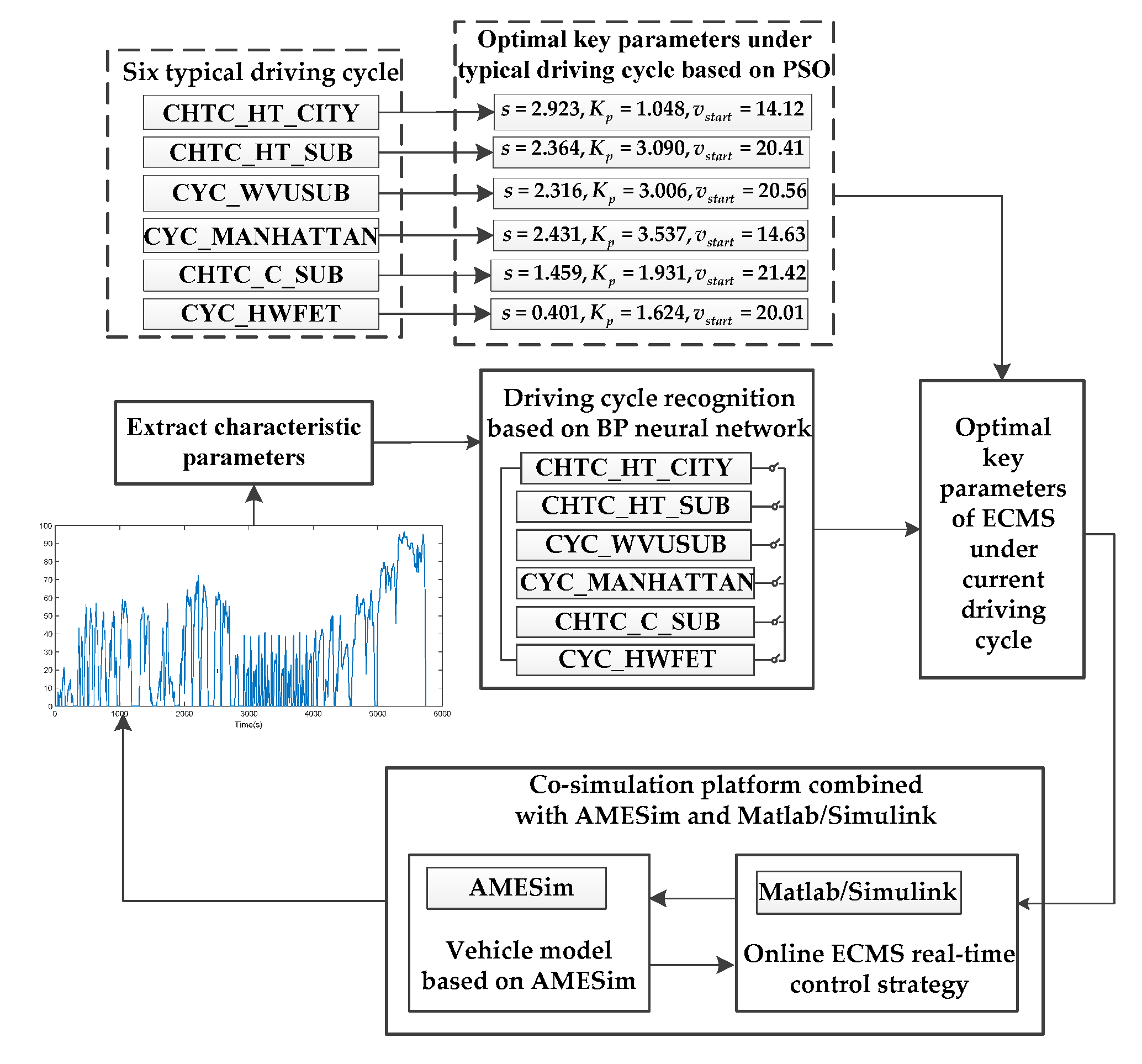
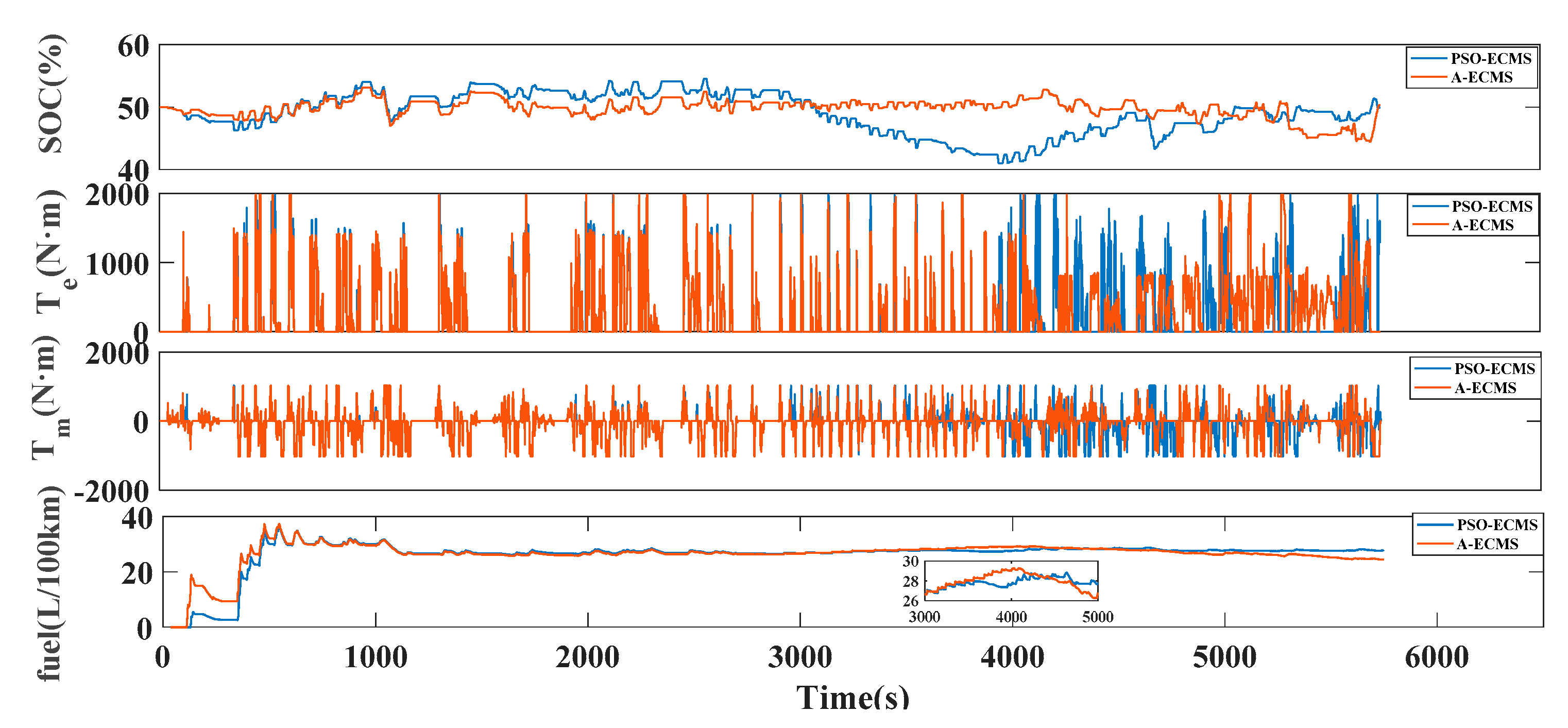
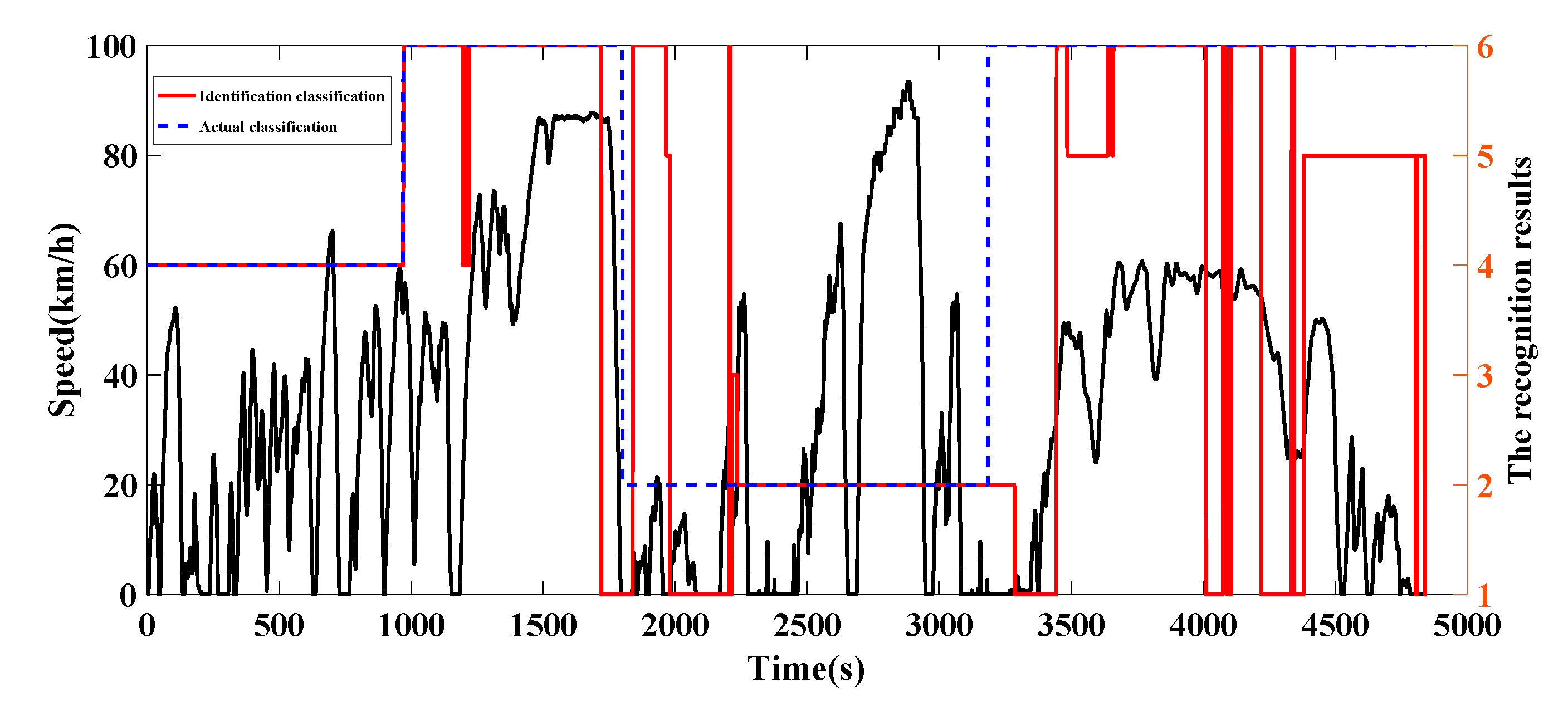
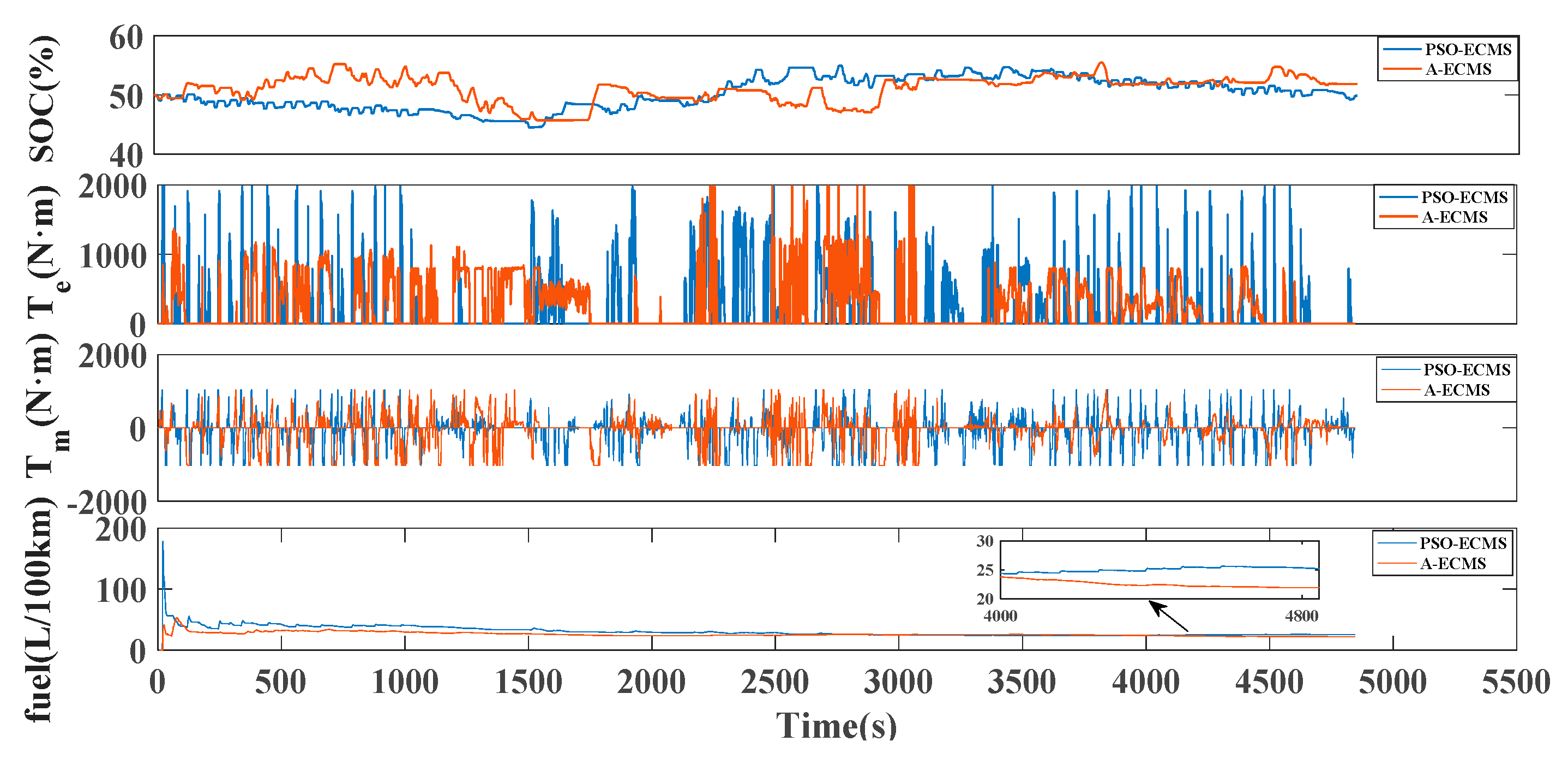
| Components | Parameters (Units) | Value |
|---|---|---|
| Engine | Displacement (L) | 11.2 |
| Maximum torque (N·m) | 2200 | |
| Maximum speed (r/min) | 2000 | |
| Motor | Maximum torque (N·m) | 1030 |
| Maximum speed (r/min) | 2600 | |
| Battery | Capacity (A·h) | 25 |
| Rated voltage (V) | 518 | |
| Transmission | Gear ratio | 16.41/13.16/11.13/8.92/7.16 5.74/4.46/3.75/2.97 2.38/1.91/1.53/1.25/1 |
| Final drive | Gear ratio | 2.87 |
| Vehicle | Curb weigh (kg) | 25,000 |
| Wheel radius (m) | 0.526 | |
| Frontal area () | 6.74 | |
| Rolling resistance coefficient | 0.004 | |
| Wind resistance coefficient | 0.5 |
| Number | Driving Cycle | Descriptions |
|---|---|---|
| 1 | CHTC_C | Driving cycle for buses in China |
| 2 | CHTC_HT | Driving cycle for trucks in China (GVW > 5500 kg) |
| 3 | CHTC_TT | Driving cycle for semi-trailer traction train in China |
| 4 | C_WTVC | Transient Vehicle Cycle for heavy-duty trucks in China |
| 5 | CYC_MANHATTAN | Driving cycle for urban bus in Manhattan |
| 6 | CYC_UDDSHDV | Driving cycle for heavy-duty vehicle of EPA |
| 7 | CYC_ WVUINTER | Driving cycle for heavy-duty vehicle in America |
| 8 | CYC_WVUSUB | Driving cycle for heavy-duty vehicle in American suburbs |
| 9 | CYC_HWFET | Highway driving cycle of EPA |
| 10 | CYC_NYCTRUCK | Driving cycle for truck in New York |
| Number | Driving Cycle | Descriptions |
|---|---|---|
| 1 | CHTC_C_CITY | Urban driving cycle for buses in China |
| 2 | CHTC_C_SUB | Suburban driving cycle for buses in China |
| 3 | CHTC_C_HW | Highway driving cycle for buses in China |
| 4 | CHTC_HT_CITY | Urban driving cycle for trucks in China (GVW > 5500 kg) |
| 5 | CHTC_HT_SUB | Suburban driving cycle for trucks in China (GVW > 5500 kg) |
| 6 | CHTC_HT_HW | Highway driving cycle for trucks in China (GVW > 5500 kg) |
| 7 | CHTC_TT_LOW | Low-speed driving cycle for semi-trailer traction train in China |
| 8 | CHTC_TT_HIGH | High-speed driving cycle for semi-trailer traction train in China |
| 9 | C_WTVC_CITY | Transient Vehicle Cycle for heavy-duty trucks in China’s city |
| 10 | C_WTVC_HW | Transient Vehicle Cycle for heavy-duty trucks in China’s highway |
| 11 | CYC_MANHATTAN | Driving cycle for urban bus in Manhattan |
| 12 | CYC_UDDSHDV | Driving cycle for heavy-duty vehicle of EPA |
| 13 | CYC_WVUINTER | Driving cycle for heavy-duty vehicle in America |
| 14 | CYC_WVUSUB | Driving cycle for heavy-duty vehicle in American suburbs |
| 15 | CYC_HWFET | Highway driving cycle of EPA |
| 16 | CYC_NYCTRUCK | Driving cycle for truck in New York |
| Driving Cycle Category | Driving Cycle Name |
|---|---|
| 1 | CHTC_C_CITY CHTC_HT_CITY CHTC_TT_LOW |
| 2 | CYC_MANHATTAN CYC_UDDSHDV CYC_NYCTRUCK |
| 3 | CYC_WVUSUB |
| 4 | CHTC_C_SUB C_WTVC_CITY |
| 5 | CHTC_HT_SUB |
| 6 | CHTC_C_HW CHTC_HT_HW CHTC_TT_HIGH C_WTVC_HW CYC_WVUINTER CYC_HWFET |
| Driving Cycle | s | v | f(x) | |
|---|---|---|---|---|
| CHTC_HT | 1.3078 | 2.09 | 23.36 | 19.83 |
| C_WTVC | 1.4532 | 4.82 | 22.02 | 20.52 |
| Combined cycle | 1.2712 | 2.04 | 23.16 | 20.23 |
| Typical Driving Cycle | s | ||
|---|---|---|---|
| CHTC_HT_CITY | 2.923 | 1.048 | 14.12 |
| CHTC_C_SUB | 2.364 | 3.090 | 20.41 |
| CYC_WVUSUB | 2.316 | 3.006 | 20.56 |
| CYC_MANHATTAN | 2.431 | 3.537 | 14.63 |
| CHTC_HT_SUB | 1.459 | 1.931 | 21.42 |
| CYC_HWFET | 0.401 | 1.624 | 20.01 |
| Strategy | Fuel Consumption | Improvement of Fuel Economy |
|---|---|---|
| ECMS | 28.82 | -- |
| PSO-ECMS | 27.94 | 3.05% |
| A-ECMS | 24.55 | 14.81% |
Publisher’s Note: MDPI stays neutral with regard to jurisdictional claims in published maps and institutional affiliations. |
© 2020 by the authors. Licensee MDPI, Basel, Switzerland. This article is an open access article distributed under the terms and conditions of the Creative Commons Attribution (CC BY) license (http://creativecommons.org/licenses/by/4.0/).
Share and Cite
Zhang, P.; Wu, X.; Du, C.; Xu, H.; Wang, H. Adaptive Equivalent Consumption Minimization Strategy for Hybrid Heavy-Duty Truck Based on Driving Condition Recognition and Parameter Optimization. Energies 2020, 13, 5407. https://doi.org/10.3390/en13205407
Zhang P, Wu X, Du C, Xu H, Wang H. Adaptive Equivalent Consumption Minimization Strategy for Hybrid Heavy-Duty Truck Based on Driving Condition Recognition and Parameter Optimization. Energies. 2020; 13(20):5407. https://doi.org/10.3390/en13205407
Chicago/Turabian StyleZhang, Pei, Xianpan Wu, Changqing Du, Hongming Xu, and Huawu Wang. 2020. "Adaptive Equivalent Consumption Minimization Strategy for Hybrid Heavy-Duty Truck Based on Driving Condition Recognition and Parameter Optimization" Energies 13, no. 20: 5407. https://doi.org/10.3390/en13205407
APA StyleZhang, P., Wu, X., Du, C., Xu, H., & Wang, H. (2020). Adaptive Equivalent Consumption Minimization Strategy for Hybrid Heavy-Duty Truck Based on Driving Condition Recognition and Parameter Optimization. Energies, 13(20), 5407. https://doi.org/10.3390/en13205407





